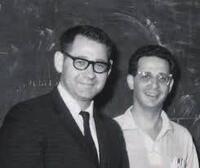
At the beginning of the 1960s, in USA, the mathematician and physicist Martin Kruskal (1925-2006) and the physicist Norman Zabusky (1929-2018) started to investigate again the FPUT system (see Section 2). They modified the nonlinear term in the interaction between springs and, together with their programmer Gary Deem, they conducted detailed numerical experiments leading to the discovery of a new phe- nomenon : they observed “solitary waves” they called “solitons” [1]. Remarkably, two solitons can collide with each other and yet preserve their shapes and speeds after collision. This properties result from a “symbiotic” balance of nonlinearity and dispersion. This numerical experiments were made at the Bell Telephone Laboratory at Whippany on IBM 709 and 7090 computers.
Kruskal and Zabusky realized that a continuous approximation of this system resulted in a partial differential equation which was proposed by Diederik Korteweg and his PhD student Gustav de Vries in 1895 ! [2] Their goal was to account for the strange waves observed and reported in the 1840s by the Scottish civil engineer John Scott Russel in a canal. Therefore, Korteweg-de Vries equation was resurrected indirectly by the work of Fermi-Pastal-Ulam-Tsingou, restarted by Kruskal and Zabusky, after having been dormant for nearly seventy years. A whole area of physics and mathematics had come into being.
In Kruskal and Zabusky’s approach, visualization is of crucial importance. This is of course routine nowadays but it was not the case at that time ; they had to develop their own visualization tools as well as the tools to interact with the programs. For them, interactive numerical experiments go well beyond an assisting tool ; the fact that one can modify parameters in real-time and visualize at once the result – and then possibly go on – builds a new intuition and relationship with equations.
We finish this section with two quotes from Zabusky :
“[I] wrote in great detail how Ulam’s book [3] had been a great stimulus for me when I discovered it in 1961. At that time I was a lonely runner in an unexplored domain, and Ulam’s ideas gave me the fortitude for the long distance I would have to cover. This was the beginning of a newmodeofworking.” (From [4].)
“From my observations and the above quotations, [5] it is clear that interactive and rapid turn-around computing provides an opportunity to concentrate deeply and develop a special intuitive “feel” for the results. This noninterrupted mode augments the innovative process.” (From [6].)